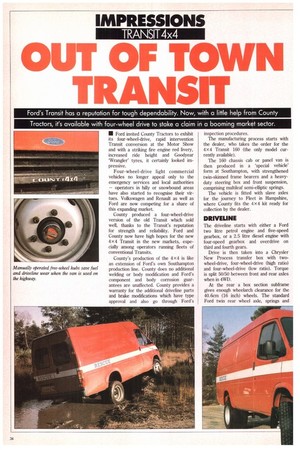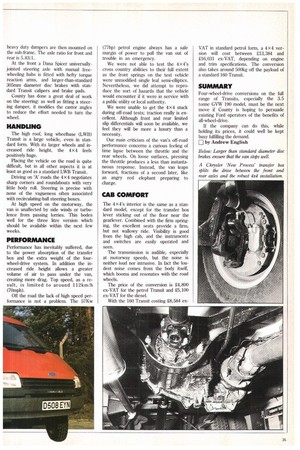OUT OF TOWN TRANSIT
Page 36

Page 37

If you've noticed an error in this article please click here to report it so we can fix it.
Ford's Transit has a reputation for tough dependability. Now, with a little help from County Tractors, it's available with four-wheel drive to stoke a claim in a booming market sector.
• Ford invited County Tractors to exhibit its four-wheel-drive, rapid intervention Transit conversion at the Motor Show and with a striking fire engine red livery, increased ride height and Goodyear 'Wrangler' tyres, it certainly looked impressive.
Four-wheel-drive light commercial vehicles no longer appeal only to the emergency services and local authorities — operators in hilly or snowbound areas have also started to recognise their virtues. Volkswagen and Renault as well as Ford are now competing for a share of this expanding market.
County produced a four-wheel-drive version of the old Transit which sold well, thanks to the Transit's reputation for strength and reliability. Ford and County now have high hopes for the new 4x4 Transit in the new markets, especially among operators running fleets of conventional Transits.
County's production of the 4X4 is like an extension of Ford's own Southampton production line. County does no additional welding or body modification and Ford's component and body corrosion guarantees are unaffected. County provides a warranty for the additional driveline parts and brake modifications which have type approval and also go through Ford's inspection procedures.
The manufacturing process starts with the dealer, who takes the order for the 4x4 Transit 160 (the only model currently available).
The 160 chassis cab or panel van is then produced in a 'special vehicle' form at Southampton, with strengthened twin-skinned frame bearers and a heavyduty steering box and front suspension, comprising multileaf semi-elliptic springs.
The vehicle is fitted with slave axles for the journey to Fleet in Hampshire, where County fits the 4x4 kit ready for collection by the dealer.
DRIVELINE
The driveline starts with either a Ford two litre petrol engine and five-speed gearbox, or a 2.5 litre diesel engine with four-speed gearbox and overdrive on third and fourth gears.
Drive is then taken into a Chrysler New Process transfer box with twowheel-drive, four-wheel-drive (high ratio) and four-wheel-drive (low ratio). Torque is split 50/50 between front and rear axles when in 4WD.
At the rear a box section subframe gives enough wheelarch clearance for the 40.6cm (16 inch) wheels. The standard Ford twin rear wheel axle, springs and
heavy duty dampers are then mounted on the sub-frame. The axle ratio for front and rear is 5.83:1.
At the front a Dana Spicer universallyjointed steering axle with manual freewheeling hubs is fitted with hefty torque reaction arms, and larger-than-standard 305nun diameter disc brakes with standard Transit calipers and brake pads.
County has done a great deal of work on the steering: as well as fitting a steering damper, it modifies the castor angles to reduce the effort needed to turn the wheel.
HANDLING
The high roof, long wheelbase (LWB) Transit is a large vehicle, even in standard form. With its larger wheels and increased ride height, the 4x4 feels positively huge.
Placing the vehicle on the road is quite difficult, but in all other aspects it is at least as good as a standard LWB Transit.
Driving on 'A' roads the 4 x4 negotiates sharp corners and roundabouts with very little body roll. Steering is precise with none of the vagueness often associated with recirculating-ball steering boxes.
At high speed on the motorway, the van is unaffected by side winds or turbulence from passing lorries. This bodes well for the three litre version which should be available within the next few weeks.
PERFORMANCE
Performance has inevitably suffered, due to the power absorption of the transfer box and the extra weight of the fourwheel-drive system. In addition the increased ride height allows a greater volume of air to pass under the van, creating more drag. Top speed, as a result, is limited to around 1 12km/h (70mph).
Off the road the lack of high speed performance is not a problem. The 57Kw
(77hp) petrol engine always has a safe margin of power to pull the van out of trouble in an emergency.
We were not able to test the 4 x4's cross country abilities to their full extent as the front springs on the test vehicle were unmodified single leaf semi-elliptics. Nevertheless, we did attempt to reproduce the sort of hazards that the vehicle would encounter if it were in service with a public utility or local authority.
We were unable to get the 4x4 stuck during off-road tests; traction really is excellent. Although front and rear limited slip differentials will soon be available, we feel they will be more a luxury than a necessity.
Our main criticism of the van's off-road performance concerns a curious feeling of time lapse between the throttle and the rear wheels. On loose surfaces, pressing the throttle produces a less than instantaneous response. Instead, the van leaps forward, fractions of a second later, like an angry red elephant preparing to charge.
CAB COMFORT
The 4 x 4's interior is the same as a standard model, except for the transfer box lever sticking out of the floor near the gearlever. Combined with the firm springing, the excellent seats provide a firm, but not wallowy ride. Visibility is good from the high cab, and the instruments and switches are easily operated and seen.
The transmission is audible, especially at motorway speeds, but the noise is neither loud nor intrusive. In fact the loudest noise comes from the body itself, which booms and resonates with the road wheels.
The price of the conversion is £4,800 ex-VAT for the petrol Transit and £5,100 ex-VAT for the diesel.
With the 160 Transit costing 28,584 ex VAT in standard petrol form, a 4 x 4 version will cost between £13,384 and £16,031 ex-VAT, depending on engine and trim specifications. The conversion also takes around 500kg off the payload of a standard 160 Transit.
SUMMARY
Four-wheel-drive conversions on the full range of Transits, especially the 3.5 tonne GVW 190 model, must be the next move if County is hoping to persuade existing Ford operators of the benefits of all-wheel-drive.
If the company can do this, while holding its prices, it could well be kept busy fulfilling the demand.
D by Andrew English












































































